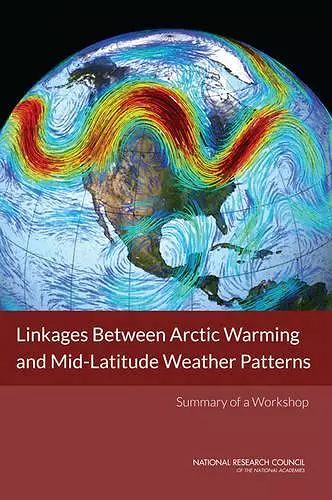Linkages Between Arctic Warming and Mid-Latitude Weather Patterns
Summary of a Workshop
National Research Council author Division on Earth and Life Studies author Polar Research Board author Board on Atmospheric Sciences and Climate author Committee on Linkages Between Arctic Sea Ice Loss and Mid-Latitude Weather Patterns: A Workshop author Katie Thomas editor
Format:Paperback
Publisher:National Academies Press
Published:29th Jun '14
Currently unavailable, and unfortunately no date known when it will be back

The Arctic has been undergoing significant changes in recent years. Average temperatures are rising twice as fast as they are elsewhere in the world. The extent and thickness of sea ice is rapidly declining. Such changes may have an impact on atmospheric conditions outside the region. Several hypotheses for how Arctic warming may be influencing mid-latitude weather patterns have been proposed recently. For example, Arctic warming could lead to a weakened jet stream resulting in more persistent weather patterns in the mid-latitudes. Or Arctic sea ice loss could lead to an increase of snow on high-latitude land, which in turn impacts the jet stream resulting in cold Eurasian and North American winters. These and other potential connections between a warming Arctic and mid-latitude weather are the subject of active research.
Linkages Between Arctic Warming and Mid-Latitude Weather Patterns is the summary of a workshop convened in September 2013 by the National Research Council to review our current understanding and to discuss research needed to better understand proposed linkages. A diverse array of experts examined linkages between a warming Arctic and mid-latitude weather patterns. The workshop included presentations from leading researchers representing a range of views on this topic. The workshop was organized to allow participants to take a global perspective and consider the influence of the Arctic in the context of forcing from other components of the climate system, such as changes in the tropics, ocean circulation, and mid-latitude sea surface temperature. This report discusses our current understanding of the mechanisms that link declines in Arctic sea ice cover, loss of high-latitude snow cover, changes in Arctic-region energy fluxes, atmospheric circulation patterns, and the occurrence of extreme weather events; possible implications of more severe loss of summer Arctic sea ice upon weather patterns at lower latitudes; major gaps in our understanding, and observational and/or modeling efforts that are needed to fill those gaps; and current opportunities and limitations for using Arctic sea ice predictions to assess the risk of temperature/precipitation anomalies and extreme weather events over northern continents.
Table of Contents- Front Matter
- Linkages Between Arctic Warming and MidLatitude Weather Patterns
- References
- Appendix A: Speaker Abstracts
- Appendix B: Workshop Agenda and Participant List
- Appendix C: Table and Schematic Presented by Session 1 Speakers
- Appendix D: Acronyms and Initialisms
- Appendix E: Biographical Sketches of...
ISBN: 9780309301886
Dimensions: unknown
Weight: unknown
85 pages